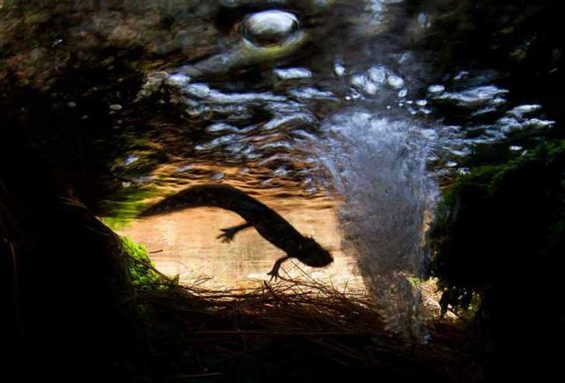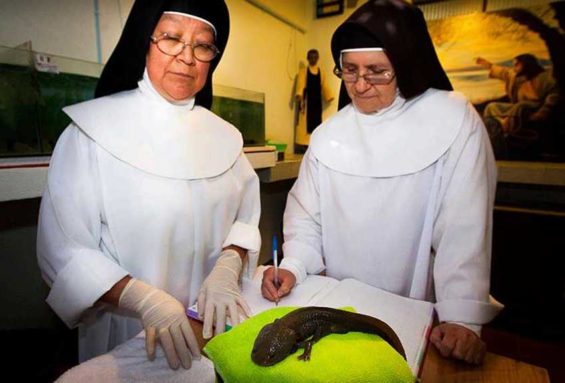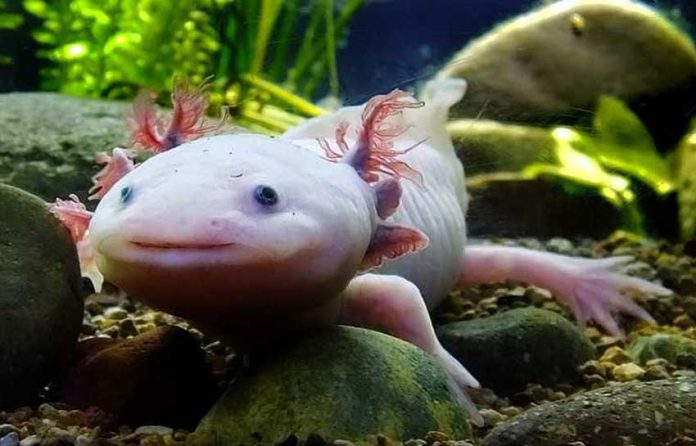Alejandro Prieto is an award-winning Mexican nature photographer whose pictures have graced the pages of publications like National Geographic and BBC Wildlife Magazine.
Prieto was born and lives in Guadalajara and has distinguished himself for his ability to capture dramatic images of elusive creatures like the Mexican jaguar, in their native habitat.
I sat down with Prieto recently to learn about his newly completed project to point his camera at Mexico’s extraordinary “walking fish,” the axolotl.
The species Ambystoma mexicanum is a kind of salamander which remains in its larval state all its life. It is not a fish at all, but it does have gills — feathery growths outside its body — as well as lungs. As if that were not enough, the axolotl can also breathe through its skin.
These abilities, however, pale before this amphibian’s true “super power:” it can regenerate not only its limbs, but just about every part of its body, including its heart and brain, for which reason it has been called “the Peter Pan of exotic creatures.”
Naturally, these characteristics have made axolotls the subject of much research into ways to regenerate human body parts, especially since the successful sequencing of its genome (10 times the size of ours) that was announced in February.
So you’d think the “Mexican Amphibian with a Mona Lisa smile” as the New York Times called it ought to be just about the most prized and protected creature on the planet — but if you had opened a newspaper a year ago you would have read that it was about to go extinct in its native habitat.
Why was such a thing allowed to happen?
This was the question that occurred to Alex Prieto a year ago when he decided to go find the answer for himself and, fortunately for the rest of us, to document and photograph everything he discovered.
I caught up with the photographer at his home high in the hills overlooking Jalisco’s Primavera Forest.
“Why is the axolotl in trouble?” I asked.

“First of all,” he said, “I should point out that the Ambystoma mexicanum is endemic to Mexico and found nowhere else. There are simply not a lot of them around to begin with. So the world was shocked not long ago when it was announced that the population of ajolotes in Lake Xochimilco — where they had thrived in pre-Hispanic times — had dropped from 6,000 per square kilometer in 1998 to only 35 in 2014, after which some researchers had claimed they couldn’t find any at all.”
The cause for this dramatic change, Prieto told me, was simply loss of habitat. Mexico has some of the world’s most stringent laws forbidding water pollution, but rarely enforces them. Axolotls can only survive in clean water and Xochimilco had serious problems.
But this is only half the problem. The other half is tilapia. This Middle East-African fish has been introduced into the lake for commercial purposes. As it is an omnivore, it not only devours the axolotl’s food, it also eats their eggs.
Even though a few axolotls can still be found in this city-enclosed lake, the species will have a hard time rebounding despite a National Autonomous University initiative launched in May.
After observing the situation in Xochimilco, Prieto traveled to visit the habitats of other varieties of Ambystomas in the rest of Mexico. He says, “I found a very beautiful kind of ajolote in Lake Zacapu in Michoacán. It’s called Ambystoma tigrinum and indeed it looks like a tiger. Unfortunately, this lake is suffering from an invasive water plant locally referred to as lirio that covers the surface and removes oxygen from the water.
“In Lake Pátzcuaro, also in Michoacán, there is another species that I believe is the biggest of all and can reach a length of about 30 centimeters, a foot long. Unfortunately, pollution is a problem in both lakes and both species are considered endangered.”

Prieto walked over to his coffee table and brought me back a thick book. “You may be surprised, but there are nuns in Pátzcuaro who breed axolotls. They’re called the Sisters of the Monastery of the Dominican Order. They raise them for medicinal purposes and sell a number of traditional products derived from axolotls.
“At the same time they cooperate in conservation projects and donate specimens to researchers who are studying these creatures. They are raising the foot-long species I mentioned before, Ambystoma dumerilii, which is yellow with red fins. So these nuns have the biggest axolotl farm in the world raising the biggest species and they have been doing this for 150 years.”
Discovering that a new species of axolotl has recently been discovered in the Sierra de Manantlán Biosphere Reserve, Prieto went to this sanctuary, which straddles the border of the states of Colima and Jalisco and, for the first time, was able to photograph an Ambystoma swimming in unpolluted water.
“In Manantlán, the water’s clean,” he told me, “but is also freezing cold, so I needed a diving suit of seven-millimeter neoprene. Another problem is that you often have to squeeze into tight spaces.
“On the other hand, it’s relatively easy to photograph axolotls because they’re not very active by day. They’re only on the move at night, when they’re hunting. They may look like they are always smiling, but when it comes to feeding or reproducing, they become very aggressive. They usually eat insects and larvae, but they are also cannibals and quite happy to eat another axolotl.”
The word axolotl, Prieto told me, means “The god who fears death,” perhaps indicating that the pre-Hispanic inhabitants of Mexico associated its ability to regenerate body parts with everlasting life.
“They had legends,” Prieto explained, “that this curious creature — often seen in their art — originated with a god who was chosen to be sacrificed but refused the honor and ran away. Finally, they say, he jumped into the water and was turned into an ajolote.”
Actually, axolotls as a species had no cause at all to fear death in pre-Hispanic times, but in the 21st century the amazing Mexican walking fish may have good reason to worry about its survival.
(Parts of this article previously appeared in The Guadalajara Reporter.)
The writer has lived near Guadalajara, Jalisco, for more than 30 years and is the author of A Guide to West Mexico’s Guachimontones and Surrounding Area and co-author of Outdoors in Western Mexico. More of his writing can be found on his website.
[soliloquy id="56314"]
